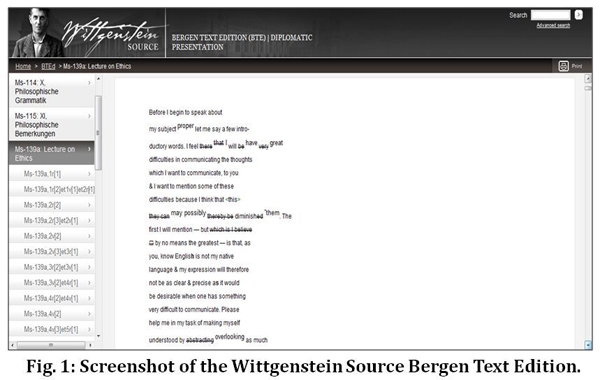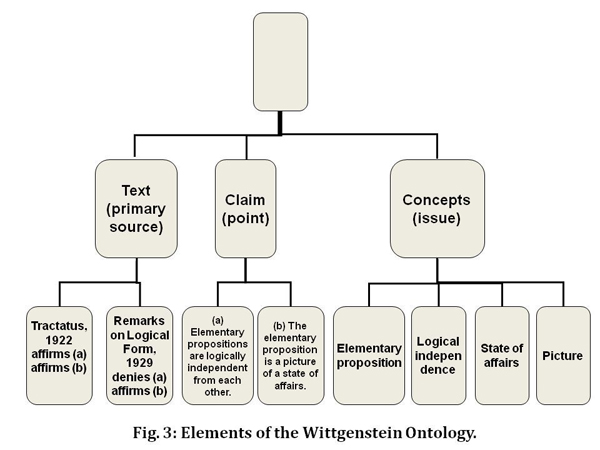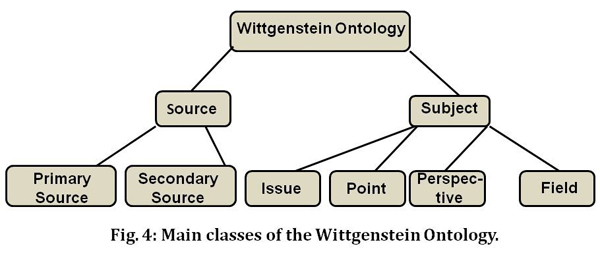Pichler, Alois, University of Bergen, Norway, Alois.Pichler@uni.no Zöllner-Weber, Amélie, University of Bergen, Norway, amelie.zoellnerweber@gmail.com
Introduction
Ludwig Wittgenstein’s 20,000 pages of manuscripts and typescripts (his ‘Nachlass’) display his continuous philosophical development and contain revisions, rearrangements and ‘multiple versioning.’ Their publication poses a number of challenges, for book as well as for digital editions (Huitfeldt 1994). Since its creation in 1990, the Wittgenstein Archives at the University of Bergen (WAB) has tried to meet these challenges through digital editorial philology. In 2000, WAB’s ‘Bergen Electronic Edition’ (BEE) of Wittgenstein’s Nachlass was published by Oxford University Press, and in 2009, 5000 pages from the Nachlass were made freely available (Open Access) on the Web ( http://www.wittgensteinsource.org/, cf. Fig. 1). Since 2001, XML-based text encoding (TEI P5) has been one of several central ingredients through which WAB has worked continuously to improve access to Wittgenstein’s manuscripts.

One key aspect of making Wittgenstein better and widely available is to prepare his works for the Semantic Web (Krüger 2007, Pichler 2010, Erbacher 2011). This, in turn, creates new possibilities for achieving deeper insights into his philosophy and intertextual relations within and between his work(s). A case study for developing an ontology for Wittgenstein’s Tractatus (1922) was published in 2007 (Zöllner-Weber & Pichler 2007). Work with the ontology received a significant boost from the EU-supported DISCOVERY project (2006-09, Smith 2007) and established that the ontology should permit interlinked browsing of philosophical concepts and primary sources. Therefore the Wittgenstein ontology includes both classes for sources and for philosophical concepts as well as properties which relate these classes. The ontology was implemented using OWL. A visualization tool (cf. Fig. 2) which allowed for coordinated use of both classes was created: Philospace/SwickyNotes which is today being further developed towards a collaborative Web based ontology browser and annotation tool (Morbidoni & Nucci 2010).

From its start, the project was faced with a major challenge: Wittgenstein’s work and philosophy are highly dynamic, multi-facetted and in continuous development. One example is Wittgenstein’s concept of ‘meaning’ which in his Tractatus is primarily linked to reference, in the middle period to rules, in the Philosophical Investigations (1953) to usage and practice, and in his last years includes yet other aspects such as ‘the atmosphere of a word.’ Even within the same period and work a term can be used in different and not always consistent ways. Many of Wittgenstein’s works are characterized by presenting a range of different views and approaches (cf. Fig. 3). Wittgenstein commentators often disagree and propose conflicting interpretations. How can such challenges be dealt with in ontologies?

In our view, providing a frame for documenting and explicating different models of the world and its domains belongs to the assets of an ontology – irrespective of these models agreeing with one other or not. Disagreement and alternative proposals can be made visible, sharable and debatable exactly through such an ontology. We regard the implementation of an ontology in the field of philosophical interpretation as an opportunity rather than as a hindrance.
When conceiving the ontology, WAB analysed different dictionaries and indices of Wittgenstein’s work, including Hanjo Glock’s valuable Wittgenstein Dictionary (Glock 1996), and philosophical dictionaries and works of reference more generally. Obviously, WAB needed a bottom-up rather than a top-down approach since its ontology should support the use of specific texts, such as the 5000 pages of Wittgenstein Source. Another important aspect was that the ontology should match and support specific tasks that WAB and its partners, including guest researchers, were involved in, such as teaching a class on Wittgenstein’s Tractatus, or joint research on Wittgenstein’s philosophy of psychology. In this way, the ontology could be tested in research as well as learning environments and developed further in cooperation with Wittgenstein experts.
Description of the ontology
On the top level, the Wittgenstein ontology is divided into two branches: Source and Subject (see Fig. 4). The Source class houses primary and secondary sources relevant for Wittgenstein research; the subclass PrimarySource divides further into Wittgenstein sources and external sources (e.g. Augustine’s Confessiones). The lowest subclass of Wittgenstein primary sources is Bemerkung and denotes the Wittgensteinian remark: typically not longer than half a page and separated from other remarks by one or more blank lines.
The Subject class contains four subclasses: Issue, Perspective, Point and Field. Issue refers to subjects dealt with by Wittgenstein himself or in Wittgenstein research, e.g. ‘elementary proposition’, ‘logical independence’, ‘picture’ and ‘state of affairs’. They denote the subjects which one would typically expect to be included in the ‘subject index’ of a comprehensive study of Wittgenstein’s philosophy. Point is a specific category developed at WAB: it refers to the point made or confirmed by an individual Wittgensteinian remark and typically contains an entire statement or a question like ‘The elementary proposition is a picture of a state of affairs’. Via the Source properties discussesIssue and hasPoint instances of Point can be interlinked with instances of Issue.

In order to provide for different modelling of the relations a Wittgensteinian subject can have, as well as to serve different user needs, WAB introduced the class Perspective. This class contains subclasses which each represent a specific grouping or filtering of the instances of Issue and Point. As an example the following may serve: Logical analysis (which is an instance of Issue) is central to the method of the philosophy from the perspective of the Tractatus, while it is not from the perspective of the Investigations. A course on the Tractatus will draw positive attention to that term, while a course on the Investigations may not even have it in its list of important subjects or start from the following instance of Point: ‘Logical analysis is not central to philosophy’. One and the same instance of Issue can enter different configurations, and even configurations which contrast with each other. For example, the subjects ‘elementary proposition’ and ‘logical independence’ are in the Tractatus (1922) and “Some Remarks on Logical Form” (SRLF, 1929) combined to configurations contrasting with each other. The first work claims: ‘Elementary propositions are logically independent from each other’, while the later denies this. The Tractatus perspective will include the claim ‘Elementary propositions are logically independent from each other’, while the later work’s perspective will include a negation (property deniesPoint) of this claim or the explicit claim: ‘Elementary propositions are not logically independent from each other’ (see Fig. 3).
In addition, the class Field was created as suggested by Grenon & Smith 2011. This field connects the Wittgenstein domain with other domains in philosophy and research more generally, e.g. epistemology or aesthetics. Users not familiar with Wittgenstein at all can enter Wittgenstein research with fields and debates from this class as their starting points. Each instance of Issue can be affiliated with one or more such field.
The name of an Issue instance consists of a German-English compound; this enables both German and English speakers to work more smoothly on the ontology, and in addition provides welcome means for precisely disambiguating and identifying the domain’s instances. Users browse the ontology with a specific language set as preference: each instance can, via rdfs:label, in principle be identified and rendered in all languages. Currently, the ontology contains about 700 Issue instances which are rendered in German, English and Danish. Renderings in Norwegian, French and Finnish are being added. WAB’s vision is that users of the ontology shall as much as possible be enabled to browse and access the Wittgenstein ontology in a language of their preference. The ontology is intended for use in the research and learning environments of different languages.
Properties are key in WAB’s ontology: they provide the relations which allow for interlinked browsing of the ontology and Wittgenstein primary sources. Properties of Bemerkung which is the most important instance of Source, include: isPartOfSource, hasAuthor, hasDifferentVersion, refersToPerson, refersToText, discussesIssue, hasPoint, deniesPoint a.o. Properties of an Issue instance can be: assertsPerspective, isRelatedToIssue, isRelevantForField, a.o. Each Bemerkung of Wittgenstein’s Nachlass shall eventually be associated by discussesIssue to at least one instance of Issue, but also take on Point properties such as hasPoint, directing to the class Point. Thereby, a scholar searching for discussions of certain issues will be steered to certain remarks, and vice versa looking at a specific remark one’s attention will be drawn also to specific issues or points.
Summary
WAB’s Wittgenstein ontology is still in its infancy, especially with regard to its Subject branch. WAB naturally cannot achieve its goal of a comprehensive Wittgenstein ontology alone: while the first version of the ontology and its overall structure were developed in the frame of the DISCOVERY project by WAB staff, it has since 2010 been strengthened by international cooperation (see http://wab.uib.no/wab_philospace.page). A key challenge in developing this ontology was to reflect Wittgenstein’s dynamic and multi-facetted work, but also Wittgenstein research’s different interpretations of this work. This was dealt with by introducing among others the class Perspective, allowing for concurring models in and about Wittgenstein’s work while maintaining a technically valid ontology. The instances of Issue are the only stable entities of the Wittgenstein subject domain; through the subclasses of Perspective they can be combined and filtered in different ways which can even contradict each other. The ontology is related to Wittgenstein primary sources via properties, enabling fast and easy studying of Wittgenstein within a common platform. In this way, research and learning about Wittgenstein can be significantly enhanced.
References
Erbacher, C. (2011). Unser Denken bleibt gefragt: Web 3.0 und Wittgensteins Nachlass. In S. Windholz and W. Feigl (eds.), Wissenschaftstheorie, Sprachkritik und Wittgenstein. Heusenstamm: ontos, pp. 135-146.
Glock, H. (1996). A Wittgenstein dictionary. Oxford: Blackwell.
Grenon, P., and B. (2011). Foundations of an ontology of philosophy.Synthese 182(2): 185-204.
Huitfeldt, C. (1994). Toward a Machine-Readable Version of Wittgenstein’s Nachlaß. Beihefte zu editio 6: 37-43.
Krüger, H. W. (2007). Wittgenstein registrieren. In Papers of the 30th International Ludwig Wittgenstein-Symposium. Kirchberg a.W.: ALWS, pp. 119-121.
Morbidoni, C., and M. Nucci (2010). SwickyNotes user guide. http://www.swickynotes.org/docs/SWickyNotesStartingGuide.pdf.
Pichler, A. (2010). Towards the New Bergen Electronic Edition. In N. Venturinha (ed.), Wittgenstein After His Nachlass. Houndmills: Palgrave Macmillan pp.157-172.
Smith, D. C. P. (2007). Re-Discovering Wittgenstein. In: Papers of the 30th International Ludwig Wittgenstein-Symposium. Kirchberg a.W.: ALWS, pp. 208-210.
Wittgenstein, L. (1922). Tractatus Logico-Philosophicus. London: Kegan Paul.
Wittgenstein, L. (1953). Philosophical Investigations. Oxford: Blackwell.
Zöllner-Weber, A., and A. Pichler (2007). Utilizing OWL for Wittgenstein’s Tractatus. In: Papers of the 30th International Ludwig Wittgenstein-Symposium. Kirchberg a.W.: ALWS, pp.248-250.

